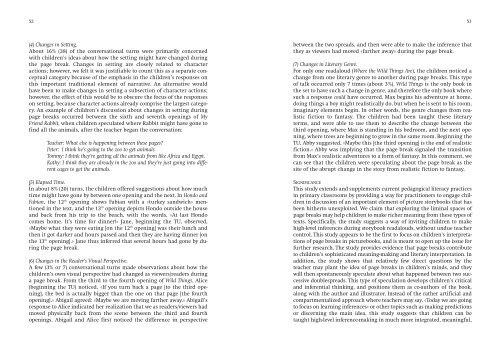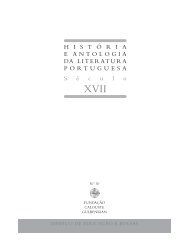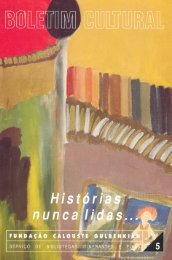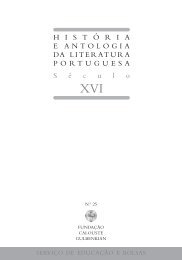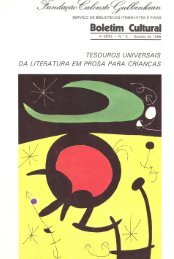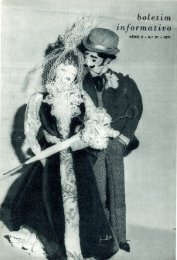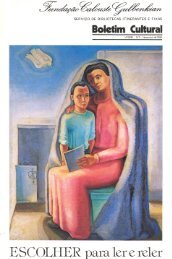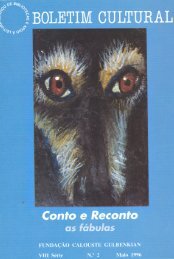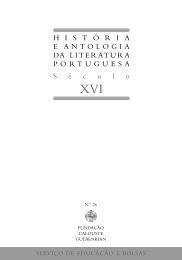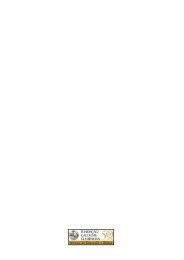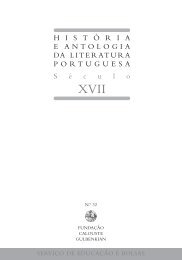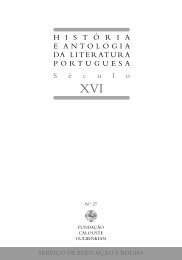Formar Leitores para Ler o Mundo - Leitura Gulbenkian - Fundação ...
Formar Leitores para Ler o Mundo - Leitura Gulbenkian - Fundação ...
Formar Leitores para Ler o Mundo - Leitura Gulbenkian - Fundação ...
You also want an ePaper? Increase the reach of your titles
YUMPU automatically turns print PDFs into web optimized ePapers that Google loves.
52<br />
(4) Changes in Setting.<br />
About 16% (38) of the conversational turns were primarily concerned<br />
with children’s ideas about how the setting might have changed during<br />
the page break. Changes in setting are closely related to character<br />
actions; however, we felt it was justifiable to count this as a se<strong>para</strong>te conceptual<br />
category because of the emphasis in the children’s responses on<br />
this important traditional element of narrative. An alternative would<br />
have been to make changes in setting a subsection of character actions;<br />
however, the effect of this would be to obscure the focus of the responses<br />
on setting, because character actions already comprise the largest category.<br />
An example of children’s discussion about changes in setting during<br />
page breaks occurred between the sixth and seventh openings of My<br />
Friend Rabbit, when children speculated where Rabbit might have gone to<br />
find all the animals, after the teacher began the conversation:<br />
Teacher: What else is happening between these pages?<br />
Peter: I think he’s going to the zoo to get animals.<br />
Tommy: I think they’re getting all the animals from like Africa and Egypt.<br />
Kathy: I think they are already in the zoo and they’re just going into different<br />
cages to get the animals.<br />
(5) Elapsed Time.<br />
In about 8% (20) turns, the children offered suggestions about how much<br />
time might have gone by between one opening and the next. In Hondo and<br />
Fabian, the 12 th opening shows Fabian with a «turkey sandwich» mentioned<br />
in the text, and the 13 th opening depicts Hondo outside the house<br />
and back from his trip to the beach, with the words, «At last Hondo<br />
comes home. It’s time for dinner!» Jane, beginning the TU, observed,<br />
«Maybe what they were eating [on the 12 th opening] was their lunch and<br />
then it got darker and hours passed and then they are having dinner [on<br />
the 13 th opening].» Jane thus inferred that several hours had gone by during<br />
the page break.<br />
(6) Changes in the Reader’s Visual Perspective.<br />
A few (3% or 7) conversational turns made observations about how the<br />
children’s own visual perspective had changed as viewers/readers during<br />
a page break. From the third to the fourth opening of Wild Things, Alice<br />
(beginning the TU) noticed, «If you turn back a page [to the third opening],<br />
the bed is actually bigger than the one on that page [the fourth<br />
opening].» Abigail agreed: «Maybe we are moving farther away.» Abigail’s<br />
response to Alice indicated her realization that we as readers/viewers had<br />
moved physically back from the scene between the third and fourth<br />
openings. Abigail and Alice first noticed the difference in perspective<br />
between the two spreads, and then were able to make the inference that<br />
they as viewers had moved «farther away» during the page break.<br />
(7) Changes in Literary Genre.<br />
For only one readaloud (Where the Wild Things Are), the children noticed a<br />
change from one literary genre to another during page breaks. This type<br />
of talk occurred only 7 times (about 3%). Wild Things is the only book in<br />
the set to have such a change in genre, and therefore the only book where<br />
such a response could have occurred. Max begins his adventure at home,<br />
doing things a boy might realistically do, but when he is sent to his room,<br />
imaginary elements begin. In other words, the genre changes from realistic<br />
fiction to fantasy. The children had been taught these literary<br />
terms, and were able to use them to describe the change between the<br />
third opening, where Max is standing in his bedroom, and the next opening,<br />
where trees are beginning to grow in the same room. Beginning the<br />
TU, Abby suggested, «Maybe this [the third opening] is the end of realistic<br />
fiction.» Abby was implying that the page break signaled the transition<br />
from Max’s realistic adventures to a form of fantasy. In this comment, we<br />
can see that the children were speculating about the page break as the<br />
site of the abrupt change in the story from realistic fiction to fantasy.<br />
SIGNIFICANCE<br />
This study extends and supplements current pedagogical literacy practices<br />
in primary classrooms by providing a way for practitioners to engage children<br />
in discussion of an important element of picture storybooks that has<br />
been hitherto unexploited. We claim that exploring the liminal spaces of<br />
page breaks may help children to make richer meaning from these types of<br />
texts. Specifically, the study suggests a way of inviting children to make<br />
high-level inferences during storybook readalouds, without undue teacher<br />
control. This study appears to be the first to focus on children’s interpretations<br />
of page breaks in picturebooks, and is meant to open up the issue for<br />
further research. The study provides evidence that page breaks contribute<br />
to children’s sophisticated meaning-making and literary interpretation. In<br />
addition, the study shows that relatively few direct questions by the<br />
teacher may plant the idea of page breaks in children’s minds, and they<br />
will then spontaneously speculate about what happened between two successive<br />
doublespreads. This type of speculation develops children’s critical<br />
and inferential thinking, and positions them as co-authors of the book,<br />
along with the author and illustrator. Instead of the rather artificial and<br />
compartmentalized approach where teachers may say, «Today we are going<br />
to focus on learning inferences» or other topics such as making predictions<br />
or discerning the main idea, this study suggests that children can be<br />
taught high-level inference-making in much more integrated, meaningful,<br />
53


